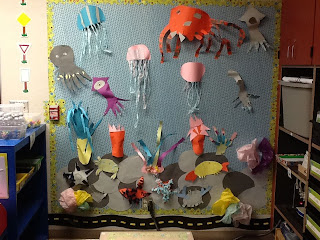Working with a second grade teacher from my school site I was able to see how she is utilizing mobile technology in her classroom. It was powerful to see her perspective on how her year is going, along with the successes and challenges. Given the district provided her with a set of six iPads, she wanted to fill the void and be able to obtain as close to a 1:1 environment, as possible. She reached out the community for used iPhones and/or iPod Touches. She was able to wrangle eleven more donated devices and has filled the remaining slots with BYOD of those students who enjoy bringing their device to and from school. At the beginning, when she was trying to go through the proper channels to green light r this program, she was hitting roadblocks from the technology department. She felt they viewed her ambitious effort as more work for them by ensuring all devices were working properly on the network and fixing any glitches. Instead, she decided to take matters into her own hands and run with the program on her own terms. There were no policies in place to stop her from the BYOD model. It was strictly that our district has kept a heavy hand in deciding the direction the program will go. It is exciting to see the accessibility she has had throughout the year and hopes that next year with the addition of more district mobile devices she won’t rely on as many BYOD. I owe her a great deal of respect for blazing trails on her own terms.
Considering she moved from Kindergarten after ten years of work, second grade was a big shift in the beginning, but it has proven to be rewarding. She reflects, “I never thought I would have more parental involvement than in Kindergarten. Parents are in their first year of their child’s education, they are excited and try hard to be involved. However, I had almost two-thirds of my students for the second time and I had established relationships previously in Kindergarten. With the addition of technology, I saw a huge shift in parents relationship with their students and offering feedback to others. It was exciting to see those who were unable to help in the classroom, spend time with us via technology. They were commenting on our blog, contributing to Google Docs, Voicethreads, etc. Each parent took it upon themselves to collaborate with us!! Overall, I had never seen such parental involvement in regards to academics.”
Some of the biggest challenges included: managing the devices, setup, updates due to the assortment of devices, and organization. She stated, “It was new to me just like the kids. We were learning together and they were so excited when they figured something out or helped solve a problem; truly empowering. One of the biggest hurdles are logins for students on a variety of web tools and apps that we use. When creating these accounts it often takes a great deal of time and then we have to make sure that each student has the information for future use. With every professional development opportunity that I attend, I am introduced to unique ideas and projects that I want to implement in my classroom. However, I have to be selective in what I try because it means exponentially more for me and my students. My goal has been to focus on a handful of tools and dig deeper with their functionality.”
What she has learned resonates deeply with me and my experiences with technology. She states, “I have never seen such high levels of engagement and interest in students’ learning! With every unit, I can see substantial growth in their academics, social skills, and it’s maturing them at rates I did not see before technology. It is exciting to see that from such an early age, these kids are learning lifelong skills that will eventually help them in the workplace, which is a huge advantage over kids just a few years ago.”










